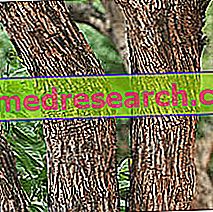Generality
The sausages are foods of animal origin. Traditionally, these are preserved meats that fall within the set of cured meats and of the first fundamental food group.

WARNING! Although most of the sausages are also a minced salami (eg salami), these two characteristics are absolutely NOT two synonyms; just think of culatello, bresaola and rolled pancetta, which involve the processing of a piece of whole meat, salted then matured after filling in a coating.
There are many types of sausages; among those with minced meat we remind: raw and not seasoned (sausage), raw and little seasoned (cotechino, pot salami, zampone, salama da sugo), raw and seasoned (salami), cooked (mortadella, wurstel, coppa di testa), smoked (nduja, smoked sausages) etc.
Covering - Animal Gut
The coating of the sausages can be natural or synthetic. The natural one consists of hollow organs, portions of them or skin of animal origin; some classic examples are the small intestine, the large intestine, the bladder, the stomach and the rind. These coverings do not always come from the same animal slaughtered for meat; in fact, considering that most of the sausages are pork-based (binomial nomenclature: Sus scrofa domesticus ) and that the adult pig is characterized by a large diameter intestine, for short-seasoned preparations, this raw material tends to be unsuitable ( instead the calf is preferred). Overall, for elongated cured meats (sausages, dried sausages, salami, etc.), the following are used: small and large intestine of the calf, small and large intestine of the horse, small and large intestine of the pig.
Regarding the sausages in bladder, the most famous are certainly the ventricina (a type of raw and seasoned salami), the salama da sugo ferrarese (a type of more or less seasoned salami, to be eaten cooked or raw, depending on the type), the culatello (a whole raw meat sausage), some fine mortadellas, very long seasoned salamis (such as the bondiola from Ferrara, even 2 years). For what concerns the sausages in rind, we mention the zampone (pig's hollow rind).
The coatings for sausages, of course, are not used "naturally". It is necessary to empty them, to dry them (to remove the mucus), to wash them, to degrease them, to sanitize them and eventually salting them, smoking them or drying them; this also applies to the bladder, but especially to the intestine. NB : For rind instead, it is essential to apply a correct scraping to eliminate all superfluous bristles.
Alternative Coatings
As anticipated, the coating of the sausages can also be of another kind. In addition to natural ones, especially at the industrial level, cellulose casings, collagen casings and collated casings are frequently used.
Cellulose casings are casings of predominantly vegetable origin but not natural. Most of the time they also contain plastic materials, in order to implement their physical characteristics; they are not edicts.
Collagen casings, on the other hand, are edible and are mainly used in the bagging of cooked meat products. They are obtained from certain meat processing scraps such as skin and bones.
Collared casings are of basically foreign production; they are based on overlapping and glued intestine trimmings. The use is the same as for animal gut.
There is a last rather different category of casings for sausages; it is 100% synthetic based, basically plastic. It is used for cooked sausages, especially those of low quality; these are placed inside them, vacuum packed, heat-sealed and cooked. Obviously, they are NOT edible.
Nutritional Features
From what I have read so far, it should be quite clear that among the various types of sausages there may be substantial differences to say the least.
Speaking of bresaola and cotechino, it is certainly not easy "to make all the grass a bundle"; we therefore try to give a general overview being as clear and correct as possible.
Certainly, all the sausages (ground or whole meat that they are) boast a high content in table salt. This ingredient, used as a preservative and seasoning, is partly (40%) composed of sodium. This mineral is potentially subject to a dietary surplus, with negative consequences for human health (obviously, reference is made to the Italian population). It seems to be responsible for the increase in blood pressure (a very important cardio vascular risk factor), even if this occurs mainly on predisposed, obese and sedentary subjects. The other known consequences of excess sodium in the diet are less known but still undesirable; these are: gastric disorders, increased risk of cancer in the digestive tract and excessive excretion of calcium through the urine (an undesirable condition for growing individuals and those at risk of osteoporosis). The sausages are therefore a "free" sodium food source which, together with the discretionary portion (added in cooking or at the table), should be eliminated or reduced drastically.
It should also be noted that most of the sausages are rich in fat. As far as energy-type molecules, or triglycerides, are concerned, in addition to being present in excess contributing to delineate a high-calorie profile (not suitable for the overweight diet), it seems to be characterized by a high quantity of saturated chains. Furthermore, fatty sausages also contain a lot of cholesterol. Saturated fatty acids are responsible for a negative metabolic impact, because (if in excess or in disequilibrium with the unsaturated ones) they favor the increase of total cholesterol and above all of the LDL fraction (bad cholesterol). Also this circumstance (worsened by the intake of cholesterol contained in cold cuts), such as hypertension, represents a very important cardio vascular risk factor.
We recall that the content of nitrates and nitrites of sausages (additives with antioxidant and preservative action) represents an unfavorable element for human health; these additives are in fact correlated to the birth of carcinogenic nitrosamines in the stomach and, assisted by the sodium surplus, favor the onset of neoplasia of the digestive tract (stomach and intestine).
Fortunately, lean and unmilled sausages (culatello, bresaola) have fewer contraindications, as they are thin and with an intake of nitrates and nitrites not comparable to others.
As for the other nutrients, sausages are an excellent source of high biological value proteins. They contain a lot of iron, which is especially important in the diet of fertile and pregnant women; however, for hygienic reasons, the raw sausages are not allowed in the dietary scheme of the latter cases.
Significant amounts of potassium are not lacking. Vitamins are also abundant (especially in group B), although dehydration and maturing significantly reduce them.
The consumption of sausages (especially fat ones) should be limited to 1-2 times a week and in portions lower than 100g (depending on the total sodium content in the diet); in the feeding of the child it would be better if they were not present and, in any case, never in a systematic way and / or with large portions.



